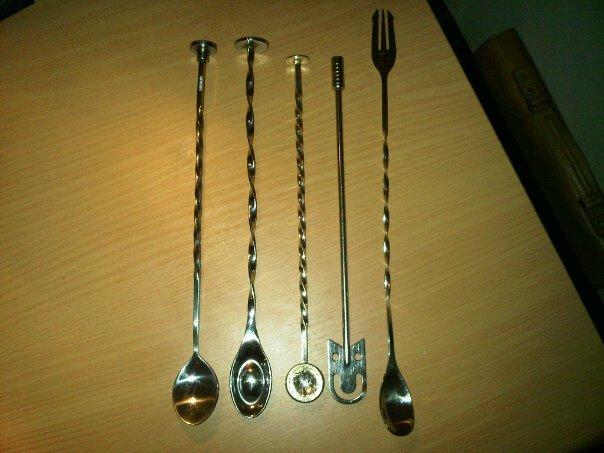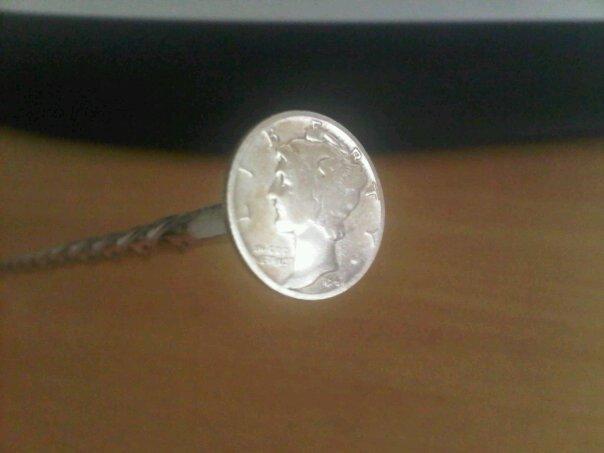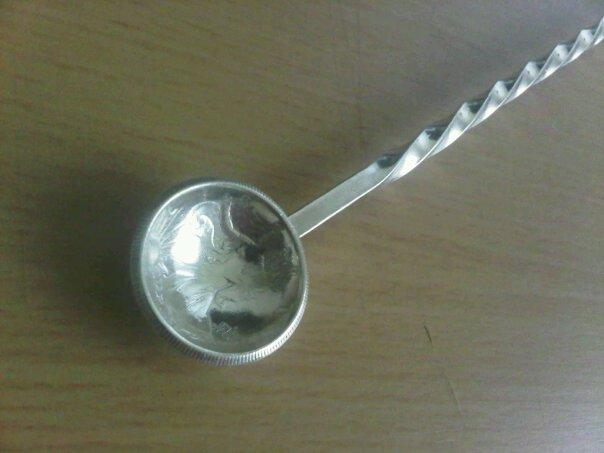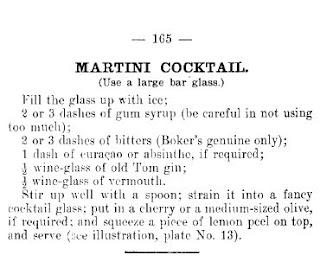-
Posts
437 -
Joined
-
Last visited
Content Type
Profiles
Forums
Store
Help Articles
Posts posted by evo-lution
-
-
Well, I happen to be sitting here sipping a Manhattan made with Dr. Adam's Bokers
Glad to hear it. Ot of curiousity what ratio/ingredients did you use?
If you get the chance visit the recipe archive on my bitters webpage (see my signature below) for a host of vintage and original Boker's recipes, as well as drinks calling for the rest of my line.
-
I really like Dr. Adam Elmegirab's Bokers Bitters. Has anyone tried San Francisco Bitters Company's Bokers Bitters? How do they compare?
I didn't know these guys existed until I looked them up just now. Judging by the botanical listing for their recipe they haven't done any research into the Boker's company and/or the original bottling. They've got things in there that weren't in the original.
They also make some strange claims regarding Khoosh Bitters ("a British proprietary tonic that was used in saloons along the Cocktail Route of San Francisco in the 1890s") considering they were never imported into the United States. We know of only two bottles of Khoosh in the World, and I have one of them, so I'm pretty sure they've never obtained a sample and/or the info required to produce a faithful reproduction.
-
Pic of the aforementioned spoons and Alessi stirring rod.
The one in the middle was made by Defaced barware (sadly no longer in existence) and is a thing of beauty with both the spoon and disc ends being old American coins. There's very few around...
-
Wanted to add to this topic, like many bartenders I've collected a number of spoons over the years and will take a picture of them all when I get the chance. Only pic I have just now is of five of them. I also purchased this today from Golden Age Bartending;

I've asked Pablo (who runs the site) about a third attachment for hand-cracking ice, or to make the muddler end heavier, and he's going to look into it for me. It may be weighty enough but I'll find out when it arrives in a few days.
-
Is any date available for when Campari was first imported into the US?
Well after 1927 when the Boulevardier first showed. Seems both the Boulevardier and Old Pal originated in Paris (unless there is something in that 1878 reference and it's not a joke of sorts)...
Where's Dr. Wondrich when you need him?
I've been speaking to Dave on email this afternoon
Some other points to consider:
The Powderhall Foot Races took place near Edinburgh, Scotland (the place of Robertson's birth).
I mentioned that in post 137.
whether cocktail culture had much of a foothold in 1870s Scotland
I think it unlikely it would have been created in Edinburgh but to address this query there was a culture of mixed drinks in and around various parts of Scotland. From what I know it was doubtful to include the likes of Campari though.
I forwarded the above to Wondrich;
Dave - "Everybody liked to joke with Sparrow, or at his expense (see Waverly Root's history of the Paris edition of the Herald, titled The Paris Edition). This is an example."My reply - "Thanks Dave, it does seem very odd but the pieces did look like they fit together. This quote "Everyone from Hemingway to The Prince of Wales was "My Old Pal" to Sparrow." coupled with what you're saying, may suggest the drink name and its alleged creator was a joke in the direction of Sparrow?"
Dave - "Yeah, that makes sense. Everybody thought he was a comical, almost half-witted character (again, according to Root), but definitely sporty."
-
Right I think that's Erik's point: Italian vermouth is normally understood as red/sweet, which not the orthodoxy for the Old Pal.
I got that, I was responding to the spelling. Anyways, the 1922 Old Pal recipe pre-dates this mention and specifies dry vermouth. Whether there's something older that contradicts this, and goes back closer to 1878 (as alluded to in Barflies & Cocktails) has yet to ascertained however let's say for argument's sake it did (and I'm beginning to think there may be something in this) it would make sense the Old Pal first called for sweet vermouth and later evolved to dry vermouth similar to drinks such as the Martini and Martinez.
Some key dates worth considering to fit the pieces together;
1878 - Old Pal alleged to have been created by Sparrow Robertson at the Old Powderhall Foot Races (see 1927)
1887 - New York Herald in Paris founded on 4th October
1890 - Harry MacElhone born in Dundee, Scotland
1911 - Harry MacElhone opens Harry's New York Bar in Paris
1921 - William Harrison "Sparrow" Robertson joins the NY Herald in Paris
1922 - Oldest known recorded recipe for the Old Pal found in Harry's ABC of Mixing Cocktails along with this line, "The drink was created by "Sparrow" Robertson, the Sporting Editor of the New York Herald in Paris."
1923 - MacElhone takes over ownership of Harry's New York Bar
1927 - Barflies & Cocktails attributes the drink to the same "Sparrow" Robertson with the following description, "I remember way back in 1878, on the 30th of February to be exact, when the Writer was discussing this subject with my old pal "Sparrow" Robertson and he said to yours truly, "get away with that stuff, my old pal, here's the drink I invented when I fired the pistol the first time at the old Powderhall foot races and you can't go wrong if you put a bet down on 1/3 Canadian Club, 1/3 Eyetalian vermouth, and 1/3 Campari." and then he told the Writer that he would dedicate this cocktail to me and call it, My Old Pal."
Anything and everything I've found relating to a Powderhall foot race which dates back to 1870 (now known as the New Year Sprint) relates to a yearly event held in Edinburgh. Taking into account that Campari hadn't made the US in 1878, that this Sparrow chap seems to have been fairly prevalent when it comes to athletics, and given his stature in the sport, would it be right to assume Sparrow a guest at the 1878 race in Edinburgh and that's where it was created? Or was there a similarly named race elsewhere. Must look into this...
I also found this line interesting - "Everyone from Hemingway to The Prince of Wales was "My Old Pal" to Sparrow."
-
Hadn't noticed the Old Pal recipe in the appendix for Barflies and Cocktails, thanks for pointing that out:
No problem. The full quote is extremely interesting (and something I have been looking into) as it suggests to me the Old Pal dates back to 1878 and pre-dates the Negroni by quite some time?!?
Uh, wait, Adam: "Eyetalian Vermouth"?Haha. At a guess, and judging by the tone of the appendix, the spelling is a humorous stab at his pronunciation of Italian.
Regarding the historic character of Canadian Whisky, Darcy O'Neil has published some articles. I suspect it was more like the juice Whiskey Pig and some of the other "negotiants" are currently selling as "Rye", than the "Canadian Club" of today.It certainly makes sense as there are too many recipes calling for either Canadian or bourbon for them to have been very close in taste/flavour.
-
So... interesting. If the original recipes called for Canadian whiskey, then I suppose it settles the question in favor of the style of vermouth being the original difference between the two drinks.
Again I'd say it's not just the vermouth, it's both*. The various Old Pal recipes from around that period call for Canadian Whiskey or Rye (with dry vermouth), and the Boulevardier is/was Bourbon (with sweet vermouth). Like other drinks I'd fully expect their to have been some form of evolution or change across different books but every one I own or have access to detail these specifics (with these same ratios). Possibly a bigger difference between Canadian and bourbon at that time?
-
In this NYT article on the Boulevardier, Toby Ceccini writes: "The drink is credited to Harry McElhone, the founder and proprietor of Harry’s New York Bar in Paris, and dated to 1927. It is mentioned only glancingly in his book “Barflies and Cocktails,” not in the 300-odd cocktail recipes that make up the bulk of that volume, but rather in a tongue-in-cheek epilogue that follows, recounting the antics of his regular customers. In a brief paragraph, he cites: “Now is the time for all good barflies to come to the aid of the party, since Erskinne Gwynne crashed in with his Boulevardier Cocktail: 1/3 Campari, 1/3 Italian vermouth, 1/3 Bourbon whisky.” McElhone’s earlier volume, “Harry’s ABC of Mixing Cocktails,” has the cocktail listed using Canadian Club as the whisky." (Emphasis mine.) Given the clear relationship between the two drinks, I would imagine the Old Pal was also originally with Canadian Club.
First known references to the Boulevardier and the Old Pal are in this article I wrote about the Negroni and its variants;
Old Pal first shows in 1922 (Harry’s ABC of Cocktails) and calls for Canadian whiskey. The Savoy later specifies Canadian Club, The Official Mixer's Manual specifies rye.
Boulevardier first shows in 1927 (Barflies and Cocktails) and calls for bourbon.
That said, I don't have an early edition of Harry's ABC to check and the Old Pal was omitted from Barflies and Cocktails.
The Old Pal is found in the appendix also calling for Canadian whiskey, and from the above blog;
...oddly, in 1927 Arthur Moss credits the drink to one 'Sparrow' Robertson, Sporting Editor of the 'New York Tribune' -
Personally think it's not solely the spirit or the vermouth, it's both. An Old Pal is a specific cocktail calling for rye and dry, as is the Boulevardier with bourbon and sweet. I'm still looking for Negroni variants so may turn up a name for an Old Pal with sweet vermouth, or a Boulevardier with dry, but nothing as yet.
-
Sorry. Next time I'll Assume. Create fictional story. Try to appear clever. I'll bear that in mind.
Anyway, this has deviated away from talk of the Negroni and its variants. Reading through Sulle Tracce Del Conte (Luca Picchi's book on the Negroni) he has a number of variants at the back with both the Cardinal and Cardinale being listed;
Cardinal3 parts gin
1 part Dry vermouth
1 part Campari
Cardinale
1 part gin
1 part Dry vermouth
1 part Campari
Both to be garnished with a lemon spiral
...when I was researching the variants I kept stumbling across these two different spellings though it was uncommon to find a difference between the two. The book would suggest that the difference is simply the ratio though I will have to dig a little deeper to ascertain if this is the case.
-
I assumed it
You really didn't need to say anything else after that. However...
...based on your saying that the Martini and Martinez are essentially the same thing, citing a 19th century recipe as evidence, the following exchange ensued:I didn't just cite a recipe as evidence, I added a link to an article I recently wrote which provides strong evidence that the Martinez and Martini were one and the same. It also covers the evolution of the Martini into the drier variant more common today.
Which makes it sound like you are reaffirming your belief that this 19th century Martini/ez is the same thing that is meant by the word Martini today. Glad we got that cleared up....but you're assumption has led to you somehow deciphering that I believe someone asking for a Martini in this day and age means they are asking for a drink which more closely resembles the Martinez as we know it, or the Martini as it was made in the late 1800s. Yup. You've cleared that up indeed.
-
Really, you had paying customers sit in front of you and ask for a Martini with no other qualifiers and you served them something with Curacao and a cherry in it without getting it sent back?
 How exactly have you assumed all that? Did you actually read what I posted? The point was about selling the Martinez. Which, as most people make it today, is almost identical to the Martini as it was first known (see picture I posted above).
How exactly have you assumed all that? Did you actually read what I posted? The point was about selling the Martinez. Which, as most people make it today, is almost identical to the Martini as it was first known (see picture I posted above). And the reason we're talking about that is because I jokingly pointed out to eje that there's little difference between a Manhattan, Martinez and Martini (in the historical sense, hence the link and picture), after he'd said he's more likely to drink the former two over the latter. Obviously aware of the fact he was speaking of the Dry Martini.
In the last decade I can only think of one guest who has ordered a Sweet Martini, and I'm 100% confident they were unaware of the Martini as it was in 1888, more likely they wanted a fashionable drink served sweeter as they don't like the more recognisable dry variant.
Thinking about it, there's a very good chance I hadn't made a Martinez in a bar, like many other bars and bartenders, until my Boker's reformulation in 2009. Particularly so as it was around this time that Old Tom also became readily available again.
Whatever their historical connection.My thoughts on that are here for anyone that is interested.
-
I dare you to serve that -- cherry and all -- to a customer.

I have. You know that Boker's thing I did? And that cocktail the Martinez? Sold quite a few of them.

"You say poh-tay-toe, I say poh-tah-toh, you say Martini, I say Martinez."
-
Depends on my mood, but I would probably be more likely to drink a Manhattan [or] Martinez, than a Martini.
But, but, they're pretty much the same thing...

-
What about orange bitters? I always use a mix of Regan's and Angostura orange bitters in mine.
There's no additional bitters in a Negroni but as with all drinks you make/take it how you want it, if you feel the need to add a few dashes of bitters to a Negroni then that's no problem at all. I sometimes add Bittermens Grapefruit or my Spanish, Dandelion & Burdock or Aphrodite, just depends how I'm feeling on any given day. However, the underlying point is that a Negroni is simple drink made up of gin, sweet vermouth and Campari, sometimes a splash of soda water as well dependent where you are in the world, and if you're tending bar and someone asks for a Negroni then chances are that's what they're after.
Aren't these different drinks? The Rosita cocktail replaces the gin with tequila, orange bitters with Angostura, but also adds dry vermouth to the recipe. The Agavoni, for example, simply replaces gin with tequila in the Negroni recipe.They may well be different though that's not the purpose of the article. The Rosita pre-dates any variant with tequila that I (or others) could find, it stands out as its own drink, has its ratios tweaked to consider the constituent parts, an interesting tale behind it as provided by Gary Regan, and already has some form of global-renown in various tomes.
The Agavoni is this; Take Negroni, leave out gin, add tequila, change 'Negr-' for 'Agav-'. Nothing wrong with that, it makes for an okay drink, but to me anyway it's not as interesting or good as the Rosita. There's less consideration and thought going into it...
-
"There's no rum in the Negroni. No brandy. No tequila. No smoke. No foams. There's no such thing as a Rum Negroni. Nor a Brandy Negroni, Bourbon Negroni or Tequila Negroni. These drinks have their own names, their own place in history, and they don't need to piggy-back on the popularity of the Negroni to gain recognition..."
To read more click here ---> The Negroni is a simple drink
Six things I have learnt since posting the Negroni article last night;
1. People really don't like it should you make any form of negative comment about Antica Formula, even if you do sing its praises at the same time. Thankfully I deleted the line about it being "Bartender's Ketchup," that would have really got their back up.
2. Some find it difficult to differentiate between opinion and fact. I like opinions, I have my own, but when fact shows our opinion is wrong then...
3. Tegroni, Cuervoni, Negrita, Agavoni, Jalisconi, Mexiconi and Margaroni are just some of the drink names being suggested I should research if I'm attempting to find a reference for a cocktail containing tequila, vermouth and Campari that pre-dates Gary Regan's Rosita that he unearthed in the late 80s. I'm not going to waste our time as these names prove the underlying point I make in the piece, Rosita it is.
4. A lot of people agree with me about the Old Pal and the Boulevardier. The former isn't that good, the latter is superb. I hazard to guess the Old Pal only gets so much attention because it contains a fashionable ingredient in rye whiskey. Save it for your Manhattan. Or Dizzy Sour.
5. A number of people have agreed I used to be adorable. I don't know what happened.
6. Those that clicked horse liked it.
-
The Fox River Cocktail is a particular favourite of mine that I've been drinking a number of whilst developing/reformulating Peach Bitters (based on bitters from late 1800s, early 1900s). Fee Peach doesn't work in this for me, and the lemon zest isn't really needed I feel.
The Mulata Daisy by Ago Perrone is also a truly sensational drink. I'd recommend this to anyone...
-
You may have read Dan Priseman's excellent piece detailing the history of the Martinez and asking the question, "What is a Martinez?"
This morning I posted my reply to Dan's article, simply put I'd say that the Martinez is exactly what Jerry Thomas detailed it as although I've tried to provide further insight which encapsulates the Manhattan, Martini and Dry Martini. A wee snippet...
"I have long suspected the lines between the Manhattan, Martinez and Martini are blurred, with the latter evolving (as we know it today) from the former two drinks but only by name, gaining popularity because of the Martini brand who I believe created it, and coupled with a switch toward drier drinks. You see, I believe the Martinez and Martini were originally one and the same, differing only due to ratios of gin and vermouth."The article can be read here.
-
Finishing the night with Tapatio Reposado, Spanish Bitters and a touch of gum syrup. Finished with white grapefruit zest. It's the simple things...
-
Enjoyed a couple of these cocktails last night and fully suspect I'll be having a few more in the very near future;
The Eager Beaver
30ml Tanqueray Gin
15ml Massenez Creme de violette
15ml Fresh apple juice
15ml Fresh lemon juice
Barspoon sugar syrup
3 Dashes Dandelion & Burdock Bitters
Fresh egg white
Method: Add egg white, lemon and sugar in that order then add remaining ingredients to mixing glass and dry shake for five seconds. Fill with cubed ice and shake hard for a further ten seconds
Glass: Coupette
Garnish: Rose bud
Ice: N/A
-
Now we get things like "bourbon negroni" or "kentucky margarita" because people need comfort zones and hand-holding which I guess is another topic entirely.
When I made my post above I actually wrote a bit of a rant as this exact thing is one of my biggest pet-hates*. I'm a great believer that stand-alone drinks will get the credit they deserve, so long as they're good. They don't need to piggy-back on better known drinks to get the recognition they deserve. Why rum Manhattan? Just call it the Palmetto. Why bourbon Negroni? Just call it the Boulevardier.
The argument often presented is that a rum Manhattan is an easier sell than a Palmetto but I don't know if that's strictly true and in my own experiences disagree with it. In some environments, such as a high volume bar, I can imagine it makes some sense (even if it does irk me) though the sort of drinks we're talking about are such that a drinker of a classic Manhattan would quite easily be drawn to a Palmetto. And in most cases bars serving these types of drinks have time to speak to their guests so...
One of the ways I got round this exact subject with a couple of menus I created for a consultancy was to list the new drink with a sub-heading linking to the more recognisable classic. For example;
Old CubanFresh mint leaves, Havana 7 year old, fresh lime juice, sugar syrup, Angostura bitters and Veuve Clicquot
alternatively try the classic Mojito with fresh mint leaves, Havana Club 3 year old, fresh lime juice, sugar syrup and soda water
1930s Cosmopolitan
Beefeater gin, Cointreau, fresh lemon juice and housemade raspberry syrup
alternatively try the 1980s Cosmopolitan with Absolut citron, Cointreau, fresh cranberry juice and fresh lime
You'd think that the 80s Cosmo would outsell the 30s due to its popularity, and I feared that may be the case, but it proved otherwise with higher sales of the 30s Cosmo.
This proved to be a very successful way of enticing drinkers of more popular beverages to try something new, they could instantly draw a comparison and in a large majority of cases it would prove to be a conversation starter as they'd want to know more about this new discovery. In a World where everyone wants to be a trend-setter of sorts, it was a clever way of making people feel like they were the first to try this new improved beverage.
*I deleted it as I've been writing a piece on this exact subject which I intend on posting on my webpage very soon.
-
“We offer classic drinks like martinis, margaritas and negronis, that are familiar to customers, but give them our own twist by making them with bourbon because it’s an indigenous American spirit, that’s very popular in the South.”
Sorry - it ain't a classic if it's made that way. Just sayin'.
A Martini made with bourbon is a Dry Manhattan of sorts, and a Negroni made with bourbon is a Boulevardier. Both classics in their own right, though granted they are not as well known as the three drinks mentioned in the piece above.
-
There are a number of essential oils that are safe for consumption that could theoretically be used in bitters for example. There are a great number of bitters (and liqueur) recipes calling for oils of this type.
I also meant to add, there are commercially available bitters brands that use essential oils in their recipes.







History of bottled cocktails?
in Spirits & Cocktails
Posted
I wrote this piece which may give you some insight - http://thejerrythomasproject.blogspot.co.uk/2011/05/bottle-and-barrel-aged-cocktails-new.html
However, Pimm's was probably one of the first bottled cocktails* when it started being produced to provide a consistent product following the success of James Pimm's Fruit Cup.
*Am I the only one who doesn't like using that term when speaking about a time when cocktails were a specific rather than an all-encapsulating term?